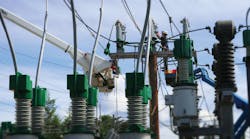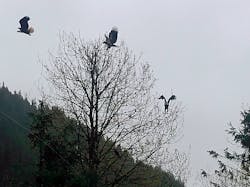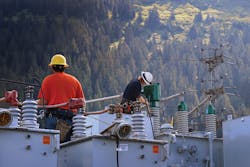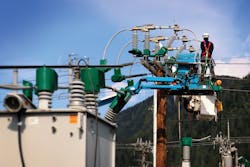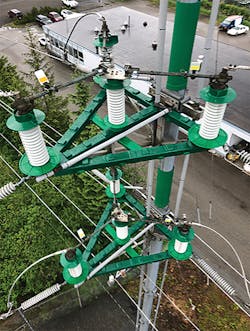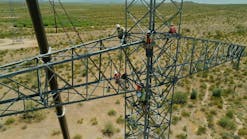Tactical eagle eyes look back at an employee gazing out the window of Alaska Electric Light & Power Co. Scanning the environment for its next bite of food, the eagle is unaware of the shadow its majestic silhouette casts down on Lemon Creek substation and the electrical hazards within it. The employee counts 1, 2, 3…12 bald eagles on any given day. Unfortunately, every year, one eagle takes its last bite when it contacts energized electrical equipment.
The good news: Today is different from the prior two decades thanks to wildlife protection improvements. Alaska Electric Light & Power (AEL&P) has implemented a new green approach. The fear once associated with the consequences of eagles flying above the substation has been transformed. Now, bald eagles seen through the office window are being admired for their resemblance to the beautiful snowcapped mountain backdrop found in Juneau, Alaska, U.S.
Wildlife Matters
Juneau is in the Tongass National Rainforest, 93 miles (150 km) from Glacier Bay National Park. No wonder its natural beauty is stunning. It also is the perfect place to find an abundance of wildlife, which makes it more challenging for AEL&P to provide reliable and responsible electric service — a challenge shared by all electric utilities. Nationally, about 20% of all power outages are attributed to wildlife. It is a little higher in Juneau, closer to 30%.
Wildlife is a broad reference to many types of animals and birds; however, the bald eagle is AEL&P’s main concern. At least one eagle-related outage occurs every year at the Lemon Creek substation. This annual event interrupts power to 58% of the utility’s 17,023 customers and accounts for about 20% of customer-outage hours each year, a system average interruption duration index of 21 minutes.
Wildlife Safety Matters
Wildlife safety matters to electric utilities. Outage response, damaged equipment, interruption of service, wildlife fatalities and the potential for regulatory fines all add up and are detrimental to the mission of utilities. AEL&P has been updating and implementing wildlife protection plans for more than 20 years, making great strides in improvements.
Countless pieces of wildlife protection products have been used system wide to improve existing infrastructure. New infrastructure takes wildlife into consideration in the design phase prior to construction. The Avian Protection Plan Guidelines by the Avian Powerline Interaction Committee (APLIC) and U.S. Fish and Wildlife Services (USFWS) serves as a resourceful basis for utility standards and planning. Wildlife protection offers social, environmental and economic benefits to utilities that support being able to provide safe, reliable, low-cost and responsible electric service. It pays to protect.
Alaska-Sized Challenge
Substations are more susceptible to wildlife interactions because of the increased amount of electrical equipment. The Lemon Creek substation is one of AEL&P’s largest facilities, integrating 69-kV transmission lines, 12.5-kV distribution feeders and a large back-up generator power plant. There are 10 back-up generators, five power transformers, voltage regulators, interrupting devices, overhead buss, support structures, instrument transformers and switches that all are potential points of interaction with birds. Across the fence from the substation is Juneau’s local landfill, which creates a vast food attractant for birds. Reminiscent of Alfred Hitchcock’s movie The Birds, droves of birds can be found by the landfill, including bald eagles.
Wildlife protection products typically target distribution-voltage-class equipment because this is where more interactions occur with more common birds like crows. Most off-the-shelf type products are designed conveniently to fit a range of commonly sized equipment like insulator bushings. A quick scan across the Lemon Creek substation reveals many of these products installed. Although they are having a positive impact, some birds still manage to come into contact with energized equipment, especially at sites with high volumes of birds like the Lemon Creek substation.
Birds are good at finding vulnerabilities in the best of wildlife protection plans. Generic products can be loose fitting, leaving gaps into which birds can poke their beaks and other body parts. It also is hard to find products for less common equipment like air-break disconnect switches or support structures.
The 69-kV transmission line enters and exits Lemon Creek substation through two Turner Electric three-way ganged operated switches mounted on steel poles. Bald eagles are big birds with wing spans up to 60 inches (152 cm). Unlike gulls or crows, the eagle’s wingspan can make it susceptible to hazardous situations from high-voltage equipment. Transmission line outages are almost certain to be fatal to an eagle and have a greater impact on system reliability.
New Green Approach
Wildlife mitigation often is a reactive approach to incidences, especially on existing electrical equipment. However, utility responses to wildlife incidences are not limited to off-the-shelf options. As Aaron Watson said at the Grizzly Rose concert in Denver, Colorado, U.S., in March 2019, “…it’s time to turn the volume up a notch; no, let’s turn it up 11 notches!” He turned the intensity way up, and AEL&P has followed suit with its wildlife protection by partnering with Greenjacket Inc. to engineer custom site-specific solutions.
The process started with an initial review of Lemon Creek substation drawings to identify perch locations and hazardous contact points for birds. Combining this information with an understanding of motivating attractants, behaviors and physiology helped to build a preliminary project scope. A site survey was needed to collect photogrammetric data for building a 3-D computer-aided model. Engineers used the model to design custom-fit polymer molded pieces that cover every contact point identified. It might not be a surprise that the number of pieces added up quickly along with the initial budget proposal.
Correlating the preliminary design with AEL&P’s incident tracking records helped to refine the scope and budget to about US$144,000 for manufacturing. A future planned solution also was engineered for another substation named West Juneau, which has a more typical substation layout as there is no power generation plant located on-site. A 69-kV transmission line is connected through an interrupting device to a 25-MVA GE power transformer. The voltage is stepped down to 12.5 kV to serve four distribution feeders. Project costs for the West Juneau project were estimated to be about $65,000. If the Lemon Creek substation project, the highest priority, is successful, then AEL&P anticipates implementing the solution at additional sites, like the West Juneau substation.
This really is “11 notches” more than past wildlife protection practices—in a good way. Utilities can capitalize successfully on demonstrated value to their customers. The potential 20% increase in reliability along with improved wildlife conservation resulted in a “turn the volume up” return on investment for AEL&P with a 25-year life expectancy. The utility’s decision to move forward with the custom-fit solution was easy when compared with alternatives like recurring transmission outages or a structure redesign project many magnitudes more.
Going Green
Shortly after making the decision, linemen began uncrating the hundreds of green polymer pieces in the Lemon Creek substation. Comparing detailed packaging labels with depicted photograph design sheets made it easy to determine where individual pieces needed to be placed. Each piece has two halves hinged together on one end. They can be installed or removed on energized equipment by qualified linemen, but AEL&P elected to deenergize its Lemon Creek substation for increased safety and to reduce time.
Once in place, the pieces were held together with pushpins, like the ones holding up molded interior panels in automobiles. The line crew would reposition an Altec bucket truck to install the next piece. Existing wildlife protection products, sometimes attached by vinyl tape or zip ties, were removed in places to prepare for the new green approach. The crew commented on the noticeable difference in desired fit and appreciated the detailed instructions.
Pieces covering buss connectors extended down and around the support bushing’s first insulator skirt. A 69-kV USCO air-break switch now has a new cover over its metal base and linkage arms, yet still allows the necessary movement to operate. No gaps for curious beaks to poke into were found on the Cooper Industries voltage regulator bushings. During three workdays, 444 pieces of wildlife protection products were installed.
Forest green complements drab gray electrical equipment as an employee gazes out the office window at the Lemon Creek substation. Why green? It turns out the color green provides better protection against ultraviolet light for a longer service life. During installation, a curious customer passing by stopped to inquire about the project activity, specifically the green pieces. The enlightened expression on the customer’s face and happy tone said it all, “Thank you!” The customer appreciated knowing the electric utility was working hard to make improvements and protect wildlife.
Does It Work?
Counting the dotted bald heads of eagles perched about the substation and hundreds, if not thousands, of crows and gulls that have been seen, it is easy to conclude Mother Nature will test AEL&P’s new green product every day. To date, the new protection equipment has passed the daily tests. Since installation almost a year ago, there have been two incidences. However, they occurred where protective covers were not installed. This helped to validate the product, and steps have been taken to add installations at these two points. So far, after one winter, the pieces have held up against the harsh windy winter weather in Alaska.
The metric for evaluating success is whether Lemon Creek substation goes one year without an eagle-related incident. This has never happened before. Continued observations are boosting the utility’s confidence. A year at Lemon Creek substation without an eagle-related transmission outage is expected to be the new norm for years to come.
For more information:
AEL&P | www.aelp.com
Cooper | www.cooperindustries.com
GE | www.ge.com
Greenjacket | https://greenjacketinc.com
USCO | www.hubbell.com
